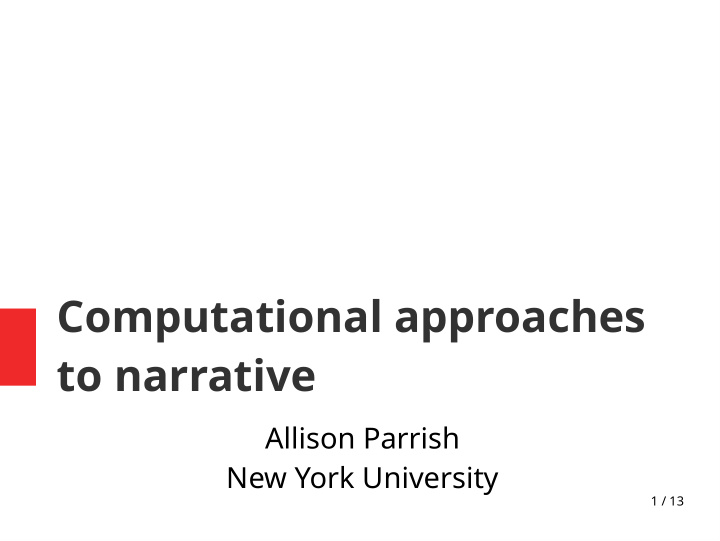



Computational approaches to narrative Allison Parrish New York University 1 / 13
What is narrative? 2 / 13
Narrative, a working definition “Narrative is the representation of an event or a series of events.” (Porter 2008) 3 / 13
Components of narrative ● narrative: story + discourse ● story: plot + space ● plot: events, ordered in time (instigated by entities in a space) ● space: characters, settings, props, etc. ("storyworld") ● discourse: a particular telling of the story (style, ordering, duration, focalization, etc.) (Adapted from Kybartas and Bidarra) 4 / 13
Our adorable structuralist model of narrative Story Discourse (order, Artifact (text, Space (setting, point of view, film, play, etc.) Plot (events) character, style...) objects) 5 / 13
6 / 13
Cinderella Plot: Space/storyworld ● ● Ill-treated heroine Château in rural France – – Fairy godmother Lady Tremaine and stepsisters – – Rags transformed into magic Glittering palace – – dress Animal friends – Meeting a prince – Discourse ● Lost shoe – Adaptations (folktale, novel, – Shoe test film) – Happy marriage Order of events (flashback?) – – (adapted from description of Cendrillon Point of view – in Cox, p. 36) Style – 7 / 13
Theories of plot Joseph Campbell’s monomyth : ● “A hero ventures forth from the world of common day into a region of supernatural wonder: fabulous forces are there encountered and a decisive victory is won: the hero comes Freytag’s pyramid ● back from this mysterious adventure with the power to Plotto (Cook) ● bestow boons on his fellow Every book of writing advice man” (Campbell, p. 23) ● ever 8 / 13
Why approach narrative with computation? 9 / 13
Interactive narratives ● Change the “plot” of the story (order of events) based on user input ● Model the storyworld in such a way that the user can “explore” it, independent of plot ● Dynamic characters respond to player action ● Tell the story from different points of view ● Etc. 10 / 13
An aid to understanding structure and aesthetics “[A]n attempt to uncover unarticulated aesthetic preferences in the human author and then force the machine to recapitulate these.”—Emily Short, Parrigues Tarot 11 / 13
Create surprises ● "If you don't invent a new technique then what you're making probably isn't new"—Phillip Glass ● Randomness + computational models = ability to produce surprises (that wouldn’t have happened otherwise) 12 / 13
Citations Kybartas, B., and R. Bidarra. “A Survey on Story Generation Techniques for ● Authoring Computational Narratives.” IEEE Transactions on Computational Intelligence and AI in Games, vol. 9, no. 3, Sept. 2017, pp. 239–53. IEEE Xplore, doi:10.1109/TCIAIG.2016.2546063. Abbott, H. Porter. The Cambridge Introduction to Narrative, 2nd edition , ● Cambridge University Press, 2008, p. 14 Cox, Marian Emily Roalfe. Cinderella; Three Hundred and Forty-Five Variants of ● Cinderella, Catskin, and Cap o’Rushes . London, The Folk-lore Society, 1893. Internet Archive, http://archive.org/details/cu31924007918299. Campbell, Joseph. The Hero with a Thousand Faces. New World Library, ● 2008. Cook, William. Plotto: The Master Book of All Plots. Tin House Books, 2011. ● 13 / 13
Recommend
More recommend